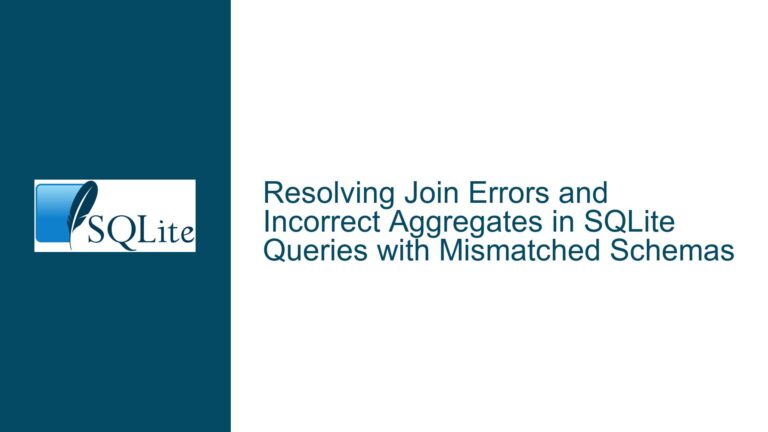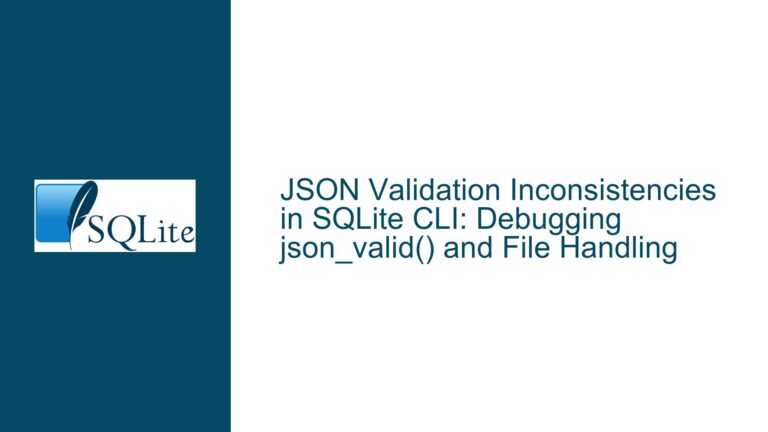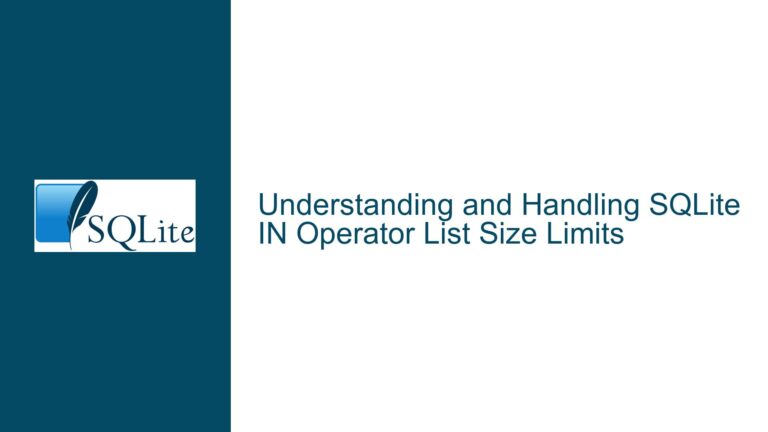SQLite JSON Operators -> and ->>: Usage, Documentation, and Confusion
Issue Overview: JSON Operators -> and ->> in SQLite
The SQLite database engine provides robust support for JSON data through its JSON1 extension, which includes two operators, -> and ->>, for extracting values from JSON strings. These operators are not documented in the Built-In Scalar SQL Functions page, leading to confusion among users who encounter them in the output of pragma_function_list. This omission has sparked discussions about their proper classification, usage, and documentation.
The -> and ->> operators are designed to simplify JSON data extraction. The -> operator extracts a JSON object or array as a JSON string, while the ->> operator extracts a scalar value (e.g., string, number, or boolean) as a SQLite text value. Despite their utility, their absence from the scalar functions documentation and their inclusion in pragma_function_list has led to ambiguity about whether they are functions or operators, how they should be invoked, and where they fit into SQLite’s broader functionality.
This confusion is compounded by the fact that these operators can be invoked using function call syntax, such as "->"('{"a": 1}', 'a'), which further blurs the line between operators and functions. Additionally, the lack of clear examples in the official documentation has left users struggling to understand their practical application, particularly when working with JSON data stored in table columns.
Possible Causes of Confusion: Classification, Syntax, and Documentation
The root of the confusion lies in three key areas: the classification of -> and ->> as operators versus functions, their syntactic behavior, and the documentation gaps.
1. Classification as Operators vs. Functions
The -> and ->> operators are implemented internally as functions, which is why they appear in the output of pragma_function_list. However, they are primarily designed to be used as operators in SQL expressions, similar to arithmetic or comparison operators. This dual nature—being both operators and functions—creates ambiguity. For example, while they can be invoked using function call syntax (e.g., "->"('{"a": 1}', 'a')), their primary use case is as infix operators (e.g., json_column -> '$.a').
2. Syntactic Behavior
The syntactic behavior of -> and ->> further complicates their classification. In SQLite, operators are typically used in infix notation (e.g., A + B), while functions are used in prefix notation (e.g., func(A, B)). The -> and ->> operators can be used in both ways, which is unusual and contributes to the confusion. For instance, the following two queries are functionally equivalent but syntactically distinct:
SELECT json_column -> '$.a' FROM my_table;
SELECT "->"(json_column, '$.a') FROM my_table;
This duality raises questions about whether they should be documented as operators, functions, or both.
3. Documentation Gaps
The official SQLite documentation does not clearly explain the -> and ->> operators in the context of scalar functions. While the JSON1 extension documentation provides some information, it does not explicitly address their inclusion in pragma_function_list or their dual nature as operators and functions. This omission leaves users to infer their behavior from examples and forum discussions, which can lead to misunderstandings.
Troubleshooting Steps, Solutions & Fixes: Clarifying Usage and Documentation
To address the confusion surrounding the -> and ->> operators, the following steps can be taken to clarify their usage, improve documentation, and provide practical examples.
1. Clarifying the Classification
The first step is to clearly classify -> and ->> as JSON extraction operators that are internally implemented as functions. This classification should be explicitly stated in the documentation to avoid ambiguity. Users should be informed that while these operators can be invoked using function call syntax, their primary use case is as infix operators in JSON expressions.
2. Providing Clear Examples
The documentation should include clear examples demonstrating the use of -> and ->> in both operator and function call syntax. These examples should cover common scenarios, such as extracting values from JSON objects and arrays, and working with JSON data stored in table columns. For instance:
-- Using -> as an operator
SELECT json_column -> '$.a' FROM my_table;
-- Using ->> as an operator
SELECT json_column ->> '$.a' FROM my_table;
-- Using -> as a function
SELECT "->"(json_column, '$.a') FROM my_table;
-- Using ->> as a function
SELECT "->>"(json_column, '$.a') FROM my_table;
These examples should be accompanied by explanations of the differences between -> and ->>, particularly how -> returns a JSON string while ->> returns a scalar value.
3. Updating the Documentation
The official SQLite documentation should be updated to include a dedicated section for JSON operators, including -> and ->>. This section should:
- Explain their purpose and behavior.
- Provide syntax examples for both operator and function call usage.
- Clarify their inclusion in
pragma_function_listand their dual nature as operators and functions. - Link to the JSON1 extension documentation for further details.
4. Addressing Common Misconceptions
The documentation should also address common misconceptions, such as the belief that -> and ->> cannot be used with table columns or that they are not true functions. This can be done by providing examples that explicitly use table columns and explaining how the operators/functions interact with JSON data in a relational context.
5. Enhancing Error Messages
SQLite’s error messages could be enhanced to provide more informative feedback when users misuse -> or ->>. For example, if a user attempts to use these operators on non-JSON data, the error message could include a suggestion to verify the data type or use the json_valid function to check for valid JSON.
6. Community Engagement
Finally, the SQLite community should be encouraged to contribute examples and explanations to the documentation. This could be facilitated through forums, GitHub issues, or other collaborative platforms. By leveraging the collective knowledge of the community, the documentation can become more comprehensive and user-friendly.
By addressing these issues, SQLite users can gain a clearer understanding of the -> and ->> operators, their proper usage, and their role in JSON data manipulation. This will not only reduce confusion but also empower users to leverage SQLite’s JSON capabilities more effectively.






